




Coulter's was a department store that originated in Downtown Los Angeles and later moved to the Miracle Mile shopping district in that same city.





Coulter's was a department store that originated in Downtown Los Angeles and later moved to the Miracle Mile shopping district in that same city.
Coulter's was founded by B. F. Coulter, a minister and entrepreneur from Kentucky, who joined the partnership Coulter & Harper in 1875, selling hardware, homeware and appliances, as well as underwear, at Eighth and Spring streets, moving to 110 Main Street in 1878.
On October 22, 1878, [1] Coulter opened his own store in the Downey Block at the corner of Temple and Main streets, selling dry goods including "gentlemen's furnishings" including neckties, as well as ladies' cloaks, hosiery, and "dress goods". This first store measured 900 square feet (84 m2) and held merchandise valued at $1,000 (~$1,342 in 2022). [2]
Coulter's philosophy was to sell exceptional quality items at a fair price, but also with exceptional customer service. The store motto in ads was "the nicest store in Los Angeles". As was common with Los Angeles retailers of the time, Coulter moved the store's location several times, as the most desirable retail districts moved away from the Plaza.
In July, 1879, Coulter's moved to its second location, the Baker Block, [3] 236 N. Main St., SE corner Main and Arcadia streets. It originally had one storefront and expanded into several more over time.
On November 1, 1884, Coulter's moved to its third location, the Hollenbeck Block, 201–205 N. Spring Street, claiming to be largest and best-lighted store in Southern California at the time. It had 3,000 square feet (280 m2) gross retail space on the ground floor and an equal amount in the basement for wholesale trade. [4]
In August, 1898, Coulter's moved to its fourth location, the Homer Laughlin Building, 317–325 S. Broadway. [5] [6] In 1905, Coulter's moved, the building was extended at the back through to Hill Street, and the Ville de Paris department store moved into the former Coulter's space. After Ville de Paris moved again, in 1917, the Grand Central Market moved into the space and occupies it to this day.
On May 31, 1905, Coulter's moved to its fifth location, a complex that renovated the Potomac Block and incorporated buildings adjacent to it: the new store's address was 225-7-9 S. Broadway and it went through to 224-6-8 S. Hill Street. [7] [8] Broadway was becoming the home of many large department stores such as J. W. Robinson's (1895), The Broadway (1896), Desmond's (1900), the Fifth Street Store (1905), Bullock's (1907), and Hamburger's (1908). [2] When Coulter's left the space in 1917 it became home to the Western Shoe Company, which changed its name in 1922 to the Western Department Store, which operated there until 1928. Lettering covered the face of the building from top to bottom through the end of the 1950s: "THE LARGEST SHOE DEPT. IN THE WEST". [9]
In 1917, Coulter's moved to its sixth location, fashionable Seventh Street, the new upmarket retail district often called "around the corner" - that is, west of the then-existing Broadway retail district, and south of Bunker Hill. Coulter's was at 711 S. Olive, the southwest corner of 7th and Olive. [2] Coulter's maintained a branch store at 215 S. Broadway.
In 1938, it relocated to its seventh and final location on the Miracle Mile on Wilshire Boulevard. [2] Again, unlike other stores that opened an additional branch on Wilshire, it moved its only store — its entire business — to Wilshire. [10]
Coulter's was purchased by the Broadway chain in 1960 and became a Broadway branch. [11]
The Streamline Moderne flagship store at 5600 Wilshire Boulevard, was designed by Stiles O. Clements and completed in 1938-39 was four stories high, as described by the Los Angeles Conservancy, "with a rounded exterior of white concrete and horizontal bands of glass block rather than proper windows. A dramatic seventy-two-foot-high panel of glass soared above the boulevard entrance". [10]
The building was nominated for listing in the National Register of Historic Places but was demolished in 1980 before the nomination was heard. [10]
The site remained - as the Conservancy described it — "a community eyesore for decades, with pools of tar and oil visible at the bottom of a deep pit" — it now a large mixed-use development. [10]
Ohrbach's was a moderate-priced department store with a merchandising focus primarily on clothing and accessories. From its modest start in 1923 until the chain's demise in 1987, Ohrbach's expanded dramatically after World War II, and opened numerous branch locations in the New York and Los Angeles metropolitan areas. Its original flagship store was located on Union Square in New York City. It maintained administrative offices in Newark and in Los Angeles. The retailer closed the Newark offices in the 1970s. Paul László designed the Union Square store as well as many of their other stores.

Broadway, until 1890 Fort Street, is a thoroughfare in Los Angeles County, California, United States. The portion of Broadway from 3rd to 9th streets, in the Historic Core of Downtown Los Angeles, was the city's main commercial street from the 1910s until World War II, and is the location of the Broadway Theater and Commercial District, the first and largest historic theater district listed on the National Register of Historic Places (NRHP). With twelve movie palaces located along a six-block stretch of Broadway, it is the only large concentration of movie palaces left in the United States.
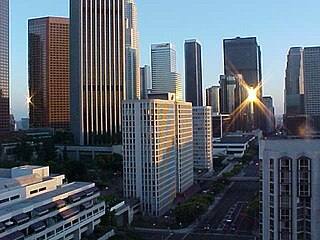
The Financial District is the central business district of Los Angeles along Olive, Grand, Hope, Flower and Figueroa streets from 4th Street to 8th Street. It is south of the Bunker Hill district, west of the Historic Core, north of South Park and east of the Harbor Freeway and Central City West. Like Bunker Hill, the Financial District is home to corporate office skyscrapers, hotels and related services as well as banks, law firms, and real estate companies. However, unlike Bunker Hill which was razed and now consists of buildings constructed since the 1960s, it contains large buildings from the early 20th century, particularly along Seventh Street, once the city's upscale shopping street; the area also attracts visitors as the 7th and Flower area is at the center of the regional Metro rail system and is replete with restaurants, bars, and shopping at two urban malls.
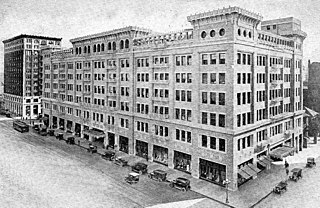
J. W. Robinson Co., Robinson's, was a chain of department stores operating in the Southern California and Arizona area, previously with headquarters in Los Angeles, California.
I. Magnin & Company was a San Francisco, California-based high fashion and specialty goods luxury department store. Over the course of its existence, it expanded across the West into Southern California and the adjoining states of Arizona, Oregon, and Washington. In the 1970s, under Federated Department Stores ownership, the chain entered the Chicago, Illinois, and Washington, DC, metropolitan areas. Mary Ann Magnin founded the company in 1876 and named the chain after her husband Isaac.
The Broadway was a mid-level department store chain headquartered in Los Angeles, California. Founded in 1896 by English-born Arthur Letts Sr., and named after what was once the city's main shopping street, the Broadway became a dominant retailer in Southern California and the Southwest. Its fortunes eventually declined, and Federated Department Stores bought the chain in 1995. In 1996, Broadway stores were either closed or converted into Macy's and Bloomingdales.

May Company California was an American chain of department stores operating in Southern California and Nevada, with headquarters in North Hollywood, California. It was a subsidiary of May Department Stores and merged with May's other Southern California subsidiary, J. W. Robinson's, in 1993 to form Robinsons-May.
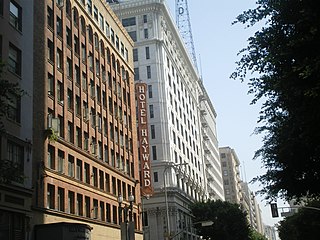
Spring Street in Los Angeles is one of the oldest streets in the city. Along Spring Street in Downtown Los Angeles, from just north of Fourth Street to just south of Seventh Street is the NRHP-listed Spring Street Financial District, nicknamed Wall Street of the West, lined with Beaux Arts buildings and currently experiencing gentrification. This section forms part of the Historic Core district of Downtown, together with portions of Hill, Broadway, Main and Los Angeles streets.

The Blackstone Building is a 1916 structure located at 901 South Broadway in Los Angeles, California. It has been listed as a Los Angeles Historic-Cultural Monument since 2003. The Blackstone Department Store Building is an early example of the work of John B. Parkinson, Los Angeles’ preeminent architect of the early 20th century, who also designed Bullocks Wilshire. The building is clad in gray terra cotta and styled in the Beaux Arts school.

The May Company Building on Broadway in Downtown Los Angeles, a.k.a. Hamburgers/May Company Department Store and the May Department Store Building, later known as the California Broadway Trade Center, was the flagship store of the May Company California department store chain. It is a contributing property to the NRHP-listed Broadway Theater and Commercial District.

Desmond's was a Los Angeles–based department store, during its existence second only to Harris & Frank as the oldest Los Angeles retail chain, founded in 1862 as a hat shop by Daniel Desmond near the Los Angeles Plaza. The chain as a whole went out of business in 1981 but Desmond's, Inc. continued as a company that went in to other chains to liquidate them. Desmond's stores in Northridge and West Covina were liquidated only in 1986 and survived in Palm Springs into the first years of the 21st century.

Harris & Frank was a clothing retailer and major chain in the history of retail in Southern California, which at its peak had around 40 stores across Southern California and in neighboring states and regions. Its history dates back to a clothing store founded by Leopold Harris in Los Angeles in 1856 near the city's central plaza, only eight years after the city had passed from Mexican to American control. Herman W. Frank joined Harris in partnership 32 years later in 1888.
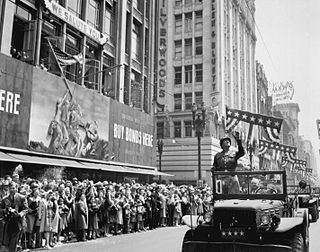
Mullen & Bluett was a Los Angeles-based department store specializing in men's clothing.

Myer Siegel was a Los Angeles–based department store, founded by Myer Siegel (1866–1934), specializing in women's clothing.
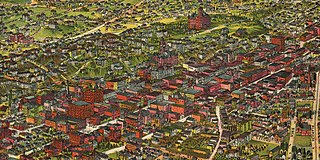
The late-Victorian-era Downtown of Los Angeles in 1880 was centered at the southern end of the Los Angeles Plaza area, and over the next two decades, it extended south and west along Main Street, Spring Street, and Broadway towards Third Street. Most of the 19th-century buildings no longer exist, surviving only in the Plaza area or south of Second Street. The rest were demolished to make way for the Civic Center district with City Hall, numerous courthouses, and other municipal, county, state and federal buildings, and Times Mirror Square. This article covers that area, between the Plaza, 3rd St., Los Angeles St., and Broadway, during the period 1880 through the period of demolition (1920s–1950s).

Jacoby Bros. was one of Los Angeles' largest dry goods retailers in the 1880s and 1890s, developing over the decades into a department store, which closed in the late 1930s.

7th Street is a street in Los Angeles, California running from S. Norton Ave in Mid-Wilshire through Downtown Los Angeles. It goes all the way to the eastern city limits at Indiana Ave., and the border between Boyle Heights, Los Angeles and East Los Angeles.

Retail in Southern California dates back to its first dry goods store that Jonathan Temple opened in 1827 on Calle Principal, when Los Angeles was still a Mexican village. After the American conquest, as the pueblo grew into a small town surpassing 4,000 population in 1860, dry goods stores continued to open, including the forerunners of what would be local chains. Larger retailers moved progressively further south to the 1880s-1890s Central Business District, which was later razed to become the Civic Center. Starting in the mid-1890s, major stores moved ever southward, first onto Broadway around 3rd, then starting in 1905 to Broadway between 4th and 9th, then starting in 1915 westward onto West Seventh Street up to Figueroa. For half a century Broadway and Seventh streets together formed one of America's largest and busiest downtown shopping districts.

Swelldom was a large women's clothing store variously described as a "cloak and suit house" and a "department store", operating from 1906 until the 1970s in California. It had locations on Broadway in Downtown Los Angeles' shopping district, later on Wilshire Blvd. at Camden in Beverly Hills, and near Union Square in San Francisco.

The Potomac Block was a commercial building with a historical role in the retail history of Los Angeles, at 213–223 S. Broadway in Downtown Los Angeles, on the west side of Broadway between 2nd and 3rd streets. It was developed by lumberyard and mill owner J. M. Griffith, designed in 1888 by Block, Curlett and Eisen in Romanesque architectural style and opened on July 17, 1890. Tenants included Ville de Paris, and City of London Dry Goods Co. It was the first time major retail stores opened on South Broadway, in what would be a shift of the shopping district from 1890 to 1905, from the 1880s-1890s central business district around Spring, Main, First and Temple streets to S. Broadway, and ever further south along Broadway.
{{cite news}}: Cite uses generic title (help){{cite news}}: CS1 maint: numeric names: authors list (link)